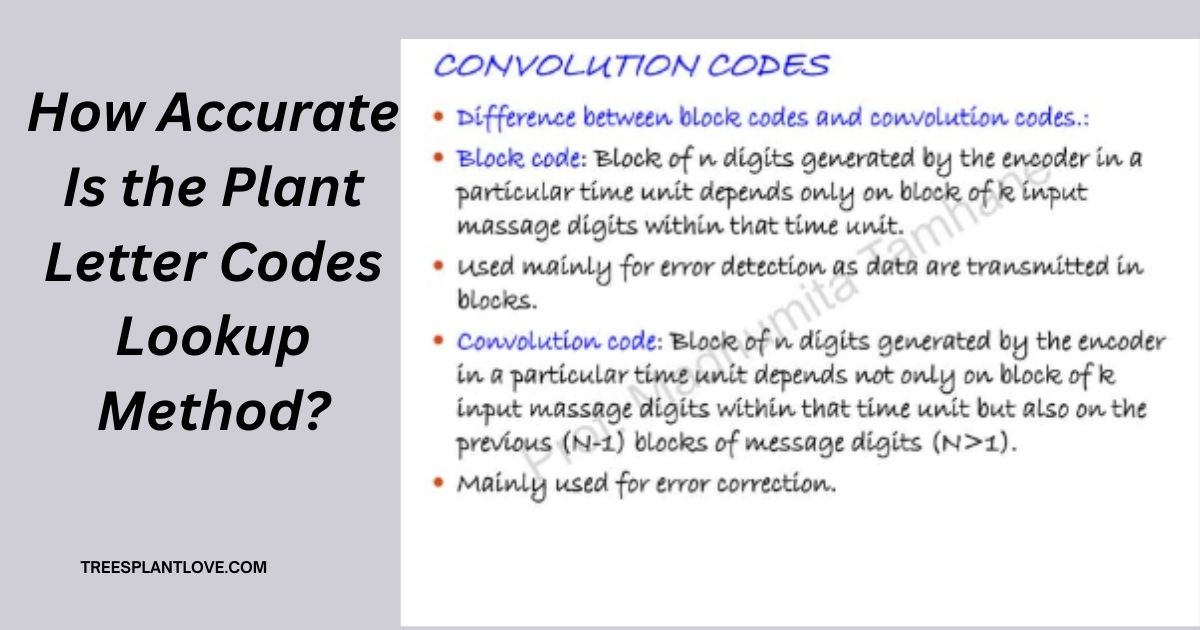
How Accurate Is the Plant Letter Codes Lookup Method? Understanding Its Reliability
How Accurate Is the Plant Letter Codes Lookup Method?: In the world of botany, gardening, and agriculture, the need for accurate plant identification is essential for a variety of purposes, from proper care and cultivation to scientific research and environmental conservation. One method that has gained popularity for simplifying plant identification is the use of plant letter codes. These codes offer a systematic approach to categorizing plants, often based on specific traits or characteristics.
However, as with any classification system, the accuracy of the plant letter codes lookup method is crucial in ensuring reliable results. In this article, we will explore how the plant letter codes lookup system works, its accuracy, potential limitations, and how it compares to other plant identification methods.
What Are Plant Letter Codes?
Plant letter codes are a shorthand system used to categorize plants based on key characteristics such as their family, genus, species, or other botanical traits. These codes typically consist of a series of letters or numbers that represent these characteristics, making it easier for botanists, horticulturists, and gardeners to identify plants quickly.
For example, a common letter code might refer to a specific plant family (like “A” for the Asteraceae family) or a particular trait (such as leaf shape or flower color). These codes can be found in various botanical references, databases, and plant identification guides, serving as a helpful shorthand for plant enthusiasts and professionals alike.
How Does the Plant Letter Codes Lookup Method Work?
The plant letter codes lookup method involves searching for a particular plant using the code associated with its characteristics. This could be a family, genus, or other botanical identifiers. Users typically refer to a lookup table or an online database, entering the code to find corresponding plants that match the description.
For example, a botanist might search for the letter code “PR” to find species in the Prunus genus, which includes cherries, plums, and apricots. With this system, individuals can quickly narrow down the options and identify the correct plant without needing to examine each plant in detail.
Many modern lookup systems now utilize databases and digital tools, allowing users to search plant letter codes online, with immediate results and cross-references to detailed plant information. These tools can enhance accuracy and efficiency for large plant collections, research projects, and educational purposes.
How Accurate Is the Plant Letter Codes Lookup Method?
While the plant letter codes lookup methodis an efficient tool, its accuracy depends on several factors. Let’s break down these factors to better understand how reliable this system is:
Quality and Standardization of the Code System
One of the primary factors determining the accuracy of plant letter codes is the quality and standardization of the system being used. Many plant letter codes are based on established botanical classification systems, such as the International Code of Nomenclature for algae, fungi, and plants (ICNafp). When these systems are used correctly, they provide a reliable way to categorize and identify plants.
However, not all systems follow the same conventions, and variations in letter codes may occur between different regions, databases, or institutions. This lack of uniformity can lead to discrepancies and confusion, making it difficult to cross-reference or identify plants consistently across different lookup platforms.
Comprehensiveness of the Lookup Database
The accuracy of the lookup method also depends on the comprehensiveness of the database or reference material being used. Some lookup systems may only cover a limited selection of plants, while others may include a vast array of species from various regions. The more extensive the database, the more accurate and reliable the plant letter codes lookup method will be.
Additionally, regularly updated databases tend to be more accurate, as they account for new discoveries, taxonomic changes, and updated scientific knowledge. A database that is out of date or incomplete may provide incorrect or outdated information, which can impact the accuracy of the lookup results.
Human Error and Interpretation
The accuracy of plant letter codes also depends on how the codes are used and interpreted. While the system itself can be quite reliable, errors can occur when individuals incorrectly input the wrong code, misinterpret the plant’s characteristics, or rely on outdated information.
Moreover, plant characteristics can sometimes be subtle or variable, meaning that a single code might refer to multiple plants with similar features. This can create ambiguity, particularly when dealing with plants that are visually similar or exhibit different traits based on environmental factors or growth stages.
Comparing with Other Identification Methods
When compared to other plant identification methods, the plant letter codes lookup method can be highly accurate, but it has some limitations. Traditional plant identification methods often involve detailed examination of physical traits, such as leaf shape, flower structure, and overall growth form. While these methods can provide precise identification, they are time-consuming and may require expert knowledge.
In contrast, plant letter codes offer a quicker and more accessible alternative, especially for general plant identification. However, the lookup method might not always be as thorough or as precise in situations where detailed observation is necessary.
For example, plant letter codes may not account for hybrids, rare species, or plants with unusual characteristics. In these cases, a more hands-on approach involving fieldwork, microscopy, or genetic analysis might be necessary for accurate identification.
Benefits and Limitations of the Plant Letter Codes Lookup Method
Benefits:
- Speed and Efficiency: Plant letter codes offer a quick way to identify plants, especially in large databases or field guides.
- Standardized System: When standardized correctly, letter codes provide a uniform way of categorizing plants.
- User-Friendly: The lookup method is accessible to amateurs and professionals alike, making plant identification easier for everyone.
Limitations:
- Potential for Confusion: Variations in coding systems and databases can lead to confusion or errors.
- Limited Coverage: Some lookup systems may not cover every plant species or genus.
- Subtle Characteristics: Some plant traits are difficult to classify using letter codes alone, leading to potential misidentification.
Conclusion
So, how accurate is the plant letter codes lookup method? The system can be highly accurate when used correctly, especially when based on well-established and standardized botanical classification systems.
However, the method’s reliability is influenced by factors such as the quality of the database, the standardization of the coding system, and the expertise of the user. While it offers a faster and more efficient alternative to traditional plant identification methods, it’s important to keep in mind the potential limitations of this approach.
For the most accurate results, it’s best to use the plant letter codes lookup method in conjunction with other identification techniques and to rely on comprehensive, up-to-date databases. This way, plant enthusiasts, researchers, and horticulturists can ensure they are making the most informed decisions when identifying plant species.

Leave a Reply